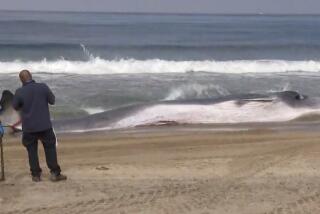GRAY WHALES
- Share via
Though hunted to near extinction in the mid-1800s, the Pacific gray whale population has grown significantly, permitting its recent removal from the endangered species list.
As their ancestors have done for thousands of years, today’s gray whale population of 20,000 to 25,000 make the 11,000 mile round-trip journey from the frigid arctic seas to the warm waters of Baja’s lagoons. The whales, traveling up to 100 miles a day, complete the trip in eight to 10 weeks. In the warm, shallow waters of Baja’s San Ignacio and Scammon lagoons and Magdalena Bay, the whales will mate or give birth to calves conceived the previous year.
In Ventura County, residents can view the southward migration of these gentle giants from December to February and again as the return from February through the end of March.
Behavior
Gray whales offer spectacular displays of spouts and splashes for whale watchers.
* When a whale surfaces to breathe, it exhales with great force, sending up a six- to 12-foot spout of warm, condensed air and sea water.
* After a series of shallow dives, whales often dive deeper, known as sounding. Tail fins, called flukes, are thrown clear of the water.
* With flukes pointing downward, gray whales sometimes extend the head above the surface as though scanning their surroundings.
* For reasons unknown--perhaps to communicate or just to play--a gray whale can propel up to three-quarters of its body out of the water, crashing with a tremendous splash.
Characteristics
Eschrichtius robustus (Common names: California Gray Whale, Pacific Gray Whale)
Length: Up to 45 feet, 15 feet at birth
Weight: 35 to 50 tons at maturity, about one ton at birth
Gestation: About 12 months. Most females calve every other year.
Life span: 30 to 40 years
Social behaviour: During migration, whales travel in small groups called pods. Calving and mating season are spent among groups of as many as 20 whales.
Unlike fish, the whale tail fins are horizontal and move up and down to propel them through the water at about 4 to 5 knots (6 mph).
Many whale calves and their mothers spend their summers in the waters between California and British Columbia, foregoing the longer trip to the colder Arctic seas until they have built up a thick layer of blubber.
Calves grow quickly feeding on mother’s milk, more than 50% fat.
Migration Routes
Southbound migration (Oct. to Feb.)
Northbound migration (Jan. to July)
Where to Watch
Two cruises a day through March 31 are offered by Cisco’s Sportfishing (985-8511, Wednesday through Sunday) or Island Packer Cruises (642-1393, daily). Prices are approximately $20 for adults and $14 for children.
Sources: World Book Encyclopedia, Peterson Guide to Mammals, American Cetacean Society, National Geographic Society, The Gray Whale Pocket Guide to Forrest Doud
Research by KRIS HOFMANN and TREVOR JOHNSTON / Los Angeles Times
More to Read
Sign up for Essential California
The most important California stories and recommendations in your inbox every morning.
You may occasionally receive promotional content from the Los Angeles Times.










